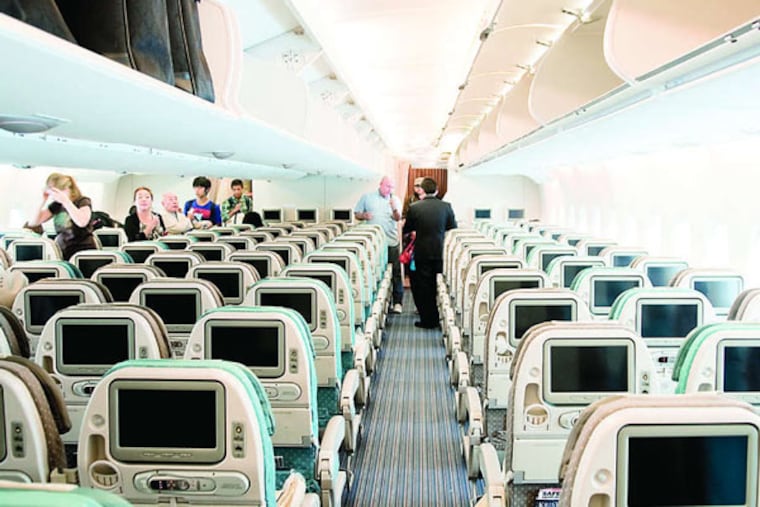GreenSpace: Tips for combatting germs on airplanes
It was a transatlantic flight, so we were in the air for seven hours. Across the aisle and one row up was the cutest little baby, who was fussing. His mother folded him in her arms and kissed the top of his head. Poor thing. He was sick.

It was a transatlantic flight, so we were in the air for seven hours.
Across the aisle and one row up was the cutest little baby, who was fussing. His mother folded him in her arms and kissed the top of his head. Poor thing. He was sick.
Five days later, so was I.
I'm not blaming the baby or the plane, but it's a fact that you're more likely to catch a cold when flying. Worldwide, there were more than 2.9 billion passenger trips on planes in 2012, according to a recent tally by the independent Worldwatch Institute in Washington.
Inevitably, a lot of those passengers will be ailing. And maybe one will have touched your very own tray table just hours before you did.
"You're not only sharing the air. You're also sharing your seat and your tray table with possibly hundreds of other passengers who occupied those same spaces," said Paul Hudson, president of the nonprofit airline passenger advocacy group FlyersRights.org.
He said that although airplane cabins are vacuumed or superficially cleaned regularly, they get a thorough cleaning only once every six or 12 months. Thus, the seats, tray tables, and carpeting are "full of germs."
For Esther Chernak, associate professor at the Drexel University School of Public Health, the biggest health concern is your proximity to other passengers.
"Think about how close you are sitting to a person in an aircraft," she said. "If someone sneezes, you're 12 to 24 inches away."
Various studies have looked at outbreaks of upper respiratory illnesses and other contagious diseases, including norovirus - the one infamous on cruise ships. "The people who get sick are people right around the known case," she said.
Dealing with that is tough, Chernak said. "The old adage, 'stay home when you're sick,' just doesn't work when you spend 300 bucks on a ticket. You get on a plane, and everyone wishes you weren't there."
The airline industry said it had made strides in keeping airborne germs from recirculating. On many planes, the air is exchanged 10 to 15 times an hour, and they have hospital-grade HEPA filters that remove 99.7 percent of particles, including most viruses, said Katie Connell, a spokeswoman for the industry group Airlines for America.
But others implicate the germs sick people leave on everything they touch. Plus, many people going on a trip are exhausted from preparations. There's the stress of a sleepless overnight flight. You're simply less able to battle microbial attackers.
Two Canadian researchers who found in a 2004 study that people taking planes were five to 113 times more likely to catch a cold than someone on the ground added the dry air on planes to the list of potential problems. Dry mucous membranes aren't doing a top-notch job of protecting you.
Chernak's advice is to wash your hands often, use a hand sanitizer (even though it doesn't kill everything), avoid hand-to-mouth behavior such nail-biting or wiping your nose, and get a flu shot.
Other experts add:
Include antiseptic wipes in your carry-on and use them on the fold-down table, armrests, headrest, and anything else you might touch.
Unless you need to look at the emergency card in the seat-back pocket, leave everything in there alone. Who knows who last thumbed through that Sky Mall magazine . . . or stuffed their used tissue beside it?
Buy a bottle of water after going through security so you have enough to sip regularly and don't risk drinking airplane water - some samples have tested positive for bacteria.
Treat the onboard bathroom with skepticism, given the number of people using it. Even if you wash your hands - with the questionable water - open the door with a paper towel and use hand sanitizer when you get back to your seat.
Likewise, be wary of the pillows and blankets the crew may hand out. You might want to opt for a balled-up sweater and your coat instead.
As for me, I spent the next nine days of vacation downing medicine I bought at a Spanish farmacia - figuring out the directions with my iPad translation app - and carrying on. There were museums to see, tapas to eat!
Not surprisingly, when it was time to go home, I was still sniffling and my cough had descended into my chest.
Sorry, fellow passengers; I got on the plane anyway. I covered my mouth, but I couldn't stop the hacking.
Hope you're all OK.
215-854-5147 @sbauers